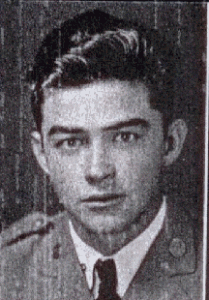Scroll of Honor – Samuel Vincent Taylor
Dive Bomber
Written by: Kelly Durham
Dive bombers, like those flown during World War II in the Pacific Theater by Navy and Marine Corps pilots, were considered more accurate than the horizontal bombers more commonly associated with the war in Europe. This was particularly true when the targets were relatively small, like bridges, ships, or the tactical positions of an enemy force. Samuel Vincent Taylor, Clemson College Class of 1937, was a dive bomber pilot with a Marine Corps’ squadron in the South Pacific.
“Dinky” Taylor came to Clemson in 1933 from Greeleyville in Williamsburg County. An agriculture major, he left Clemson after completing three and a half years of school.
By 1942, Taylor had joined the Marines and had qualified for flight training. His initial training was at the Naval Reserve aviation base in Atlanta. He was then sent to Pensacola Naval Air Station in Florida and he was awarded his wings as a Marine Corps pilot at Miami in July 1942.
 By the winter of 1943, Taylor was a first lieutenant assigned to VMSB 144, a Marine scouting/bombing squadron based at Henderson Field on Guadalcanal. The squadron, flying Douglas Dauntless SBD-4 dive bombers, completed its first combat tour in mid-March and then joined its ground echelon on Efate, in the South Pacific some 400 miles northeast of New Caledonia on the eastern edge of the Coral Sea.
By the winter of 1943, Taylor was a first lieutenant assigned to VMSB 144, a Marine scouting/bombing squadron based at Henderson Field on Guadalcanal. The squadron, flying Douglas Dauntless SBD-4 dive bombers, completed its first combat tour in mid-March and then joined its ground echelon on Efate, in the South Pacific some 400 miles northeast of New Caledonia on the eastern edge of the Coral Sea.
Even though the squadron was out of combat, training in the art of dive bombing continued. The Army Air Force’s heavy bombers employed the secret Norden bombsight to drop bombs accurately from high altitudes—with decidedly mixed results. Taylor and his comrades delivered their bombs on target not by relying on a highly technical, highly classified bombsight, but by simply aiming their aircraft directly at the target. As the bomber dove toward its target, the pilot could adjust his aim by tweaking the angle of his dive. This, of course, required practice.
On Tuesday, May 25, 1943, First Lieutenant Taylor was leading a five-aircraft formation on a practice dive bombing mission at Monument Rock on the north side of Efate. At approximately 1300 hours, Taylor and the number two aircraft piloted by Lieutenant George Huffman, began their dives with what appeared to be normal intervals. No one saw or heard a collision, but moments later, debris from both aircraft was seen falling from an estimated altitude of three thousand feet. Two parachutes were seen, but no one was attached to the first and the other was lost in the sea before it could be determined if anyone was strapped to it. Two oil slicks were sighted by a crash boat that responded to the accident, but neither Taylor nor Huffman, nor their gunners Private First Class Henry Kemper, Jr. and Corporal Paul Walker, were ever found.
First Lieutenant Samuel Vincent Taylor is memorialized at the Honolulu Memorial in Hawaii.
For more information on Samuel Vincent Taylor see:
https://soh.alumni.clemson.edu/scroll/samuel-vincent-taylor/
For additional information about Clemson University’s Scroll of Honor visit:
https://soh.alumni.clemson.edu/
